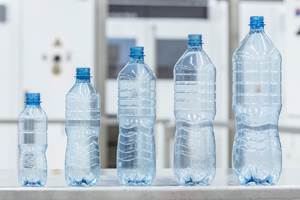Food Packaging Should Remain Strong
But industrial markets could slip.
There are three primary industries that we track that drive packaging demand: food, retail (primarily trash and t-shirt bags), and industrial (primarily shipping materials). In our January report, all three industries looked to be doing well. But things have recently changed. While food packaging should see continued strength—if not growth—retail packaging and institutional packaging seem poised for a contraction. Here’s why:
Real Disposable Income. April real disposable income was $12.56 billion (seasonally adjusted at an annual rate), an all-time high. Moreover, the data for the fourth quarter of 2015 and the first quarter of 2016 generally was revised higher. In April, real disposable income grew 3.3% compared with one year ago, which was slightly faster than the historical average growth rate. In the first four months of 2016, the month-over-month rate of growth has accelerated from its low of 3% in December 2015. However, the annual rate of growth has remained unchanged at 3.4%.
Food Packaging. Somewhat surprisingly, real disposable income tends to lead food and beverage spending by almost a year. Food and beverage spending contracted at a very modest rate in 2015. But with the strong growth in income, food and beverage spending has grown at a rapidly accelerating rate in the first four months of 2016. The annual rate of growth in spending has gone from -0.1% in November to 0.7% (about half the historical average) in April. But the annual rate of growth should continue to accelerate as three of the last four months had spending growth at 1.3% or more compared with one year ago. In turn, food and beverage spending tends to lead food and beverage production. Food and beverage production was already growing at nearly its fastest rate in eight years. If food and beverage spending continues to grow at an accelerating rate, then food packaging should be poised for further growth in 2016.
Retail Packaging. Probably the best proxy for retail packaging is the clothing and footwear industry. Consumer spending on clothing and footwear has been growing at a decelerating rate since the fall of 2015. However, other than the spike in 2011, the current rate of growth in clothing spending was still one of the fastest since late 2006. Production of clothing and footwear has been virtually flat over the last six to 12 months. The retail packaging market seems to be flat at best, which is not surprising given the recent poor results of many major retailers.
Institutional Packaging. Primarily, institutional packaging consists of stretch film and sheet and tubing, but consumer and industrial product liners and shrink film also are a significant part of institutional packaging. Since all of this packaging is used to ship product, tracking the changes in the trucking industry can provide a good estimate of what is happening with institutional packaging.
The Bureau of Transportation Services has an index for the freight industry, and it has come down from its record highs. Compared with one year ago, the index has declined in three of the last five months. While the index was still growing year-over-year in March, it’s likely that the annual rate of change will begin contracting soon. This is a negative sign for institutional packaging.
ABOUT THE AUTHOR
Steven Kline Jr. is part of the fourth-generation ownership team of Cincinnati-based Gardner Business Media, which is the publisher of Plastics Technology. He is currently the company’s director of market intelligence. Contact: (513) 527-8800 email:skline2@gardnerweb.com
blog: gardnerweb.com/economics/blog
Related Content
First Water Bottles With Ultrathin Glass Coating
Long used for sensitive juices and carbonated soft drinks, KHS Freshsafe PET Plasmax vapor-deposited glass coating is now providing freshness and flavor protection for PET mineral water bottles.
Read MorePlastics Technology Year in Review: Your Favorite Reads of 2024
A year-end review of the top stories showcasing industry trends, advancements and expert insights. Revisit the articles that captured the attention of the plastics community.
Read MoreProcessing Megatrends Drive New Product Developments at NPE2024
It’s all about sustainability and the circular economy, and it will be on display in Orlando across all the major processes. But there will be plenty to see in automation, AI and machine learning as well.
Read MoreMultilayer Solutions to Challenges in Blow Molding with PCR
For extrusion blow molders, challenges of price and availability of postconsumer recycled resins can be addressed with a variety of multilayer technologies, which also offer solutions to issues with color, processability, mechanical properties and chemical migration in PCR materials.
Read MoreRead Next
Making the Circular Economy a Reality
Driven by brand owner demands and new worldwide legislation, the entire supply chain is working toward the shift to circularity, with some evidence the circular economy has already begun.
Read MoreSee Recyclers Close the Loop on Trade Show Production Scrap at NPE2024
A collaboration between show organizer PLASTICS, recycler CPR and size reduction experts WEIMA and Conair recovered and recycled all production scrap at NPE2024.
Read MorePeople 4.0 – How to Get Buy-In from Your Staff for Industry 4.0 Systems
Implementing a production monitoring system as the foundation of a ‘smart factory’ is about integrating people with new technology as much as it is about integrating machines and computers. Here are tips from a company that has gone through the process.
Read More
.JPG;width=70;height=70;mode=crop)






















